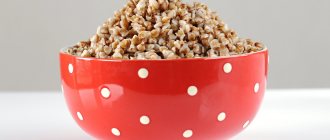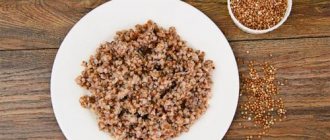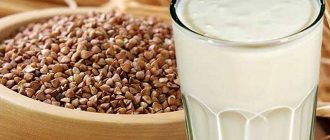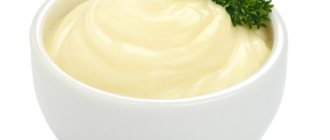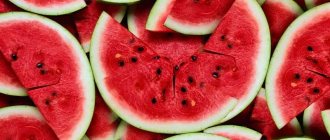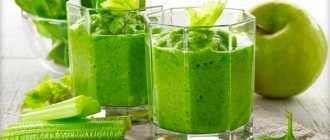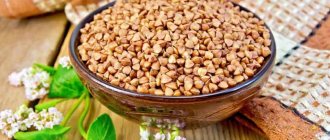Chemical composition and nutritional value of buckwheat
Buckwheat is rich in minerals. Potassium, magnesium, manganese, copper, phosphorus in boiled buckwheat are well absorbed because there is little phytic acid in the cereal grain:
- Potassium - 100 g of product contains 12.8% of the daily requirement. Normalizes blood pressure and regulates the functioning of the heart muscle.
- Magnesium - 37.5%. Regular consumption of buckwheat porridge normalizes sleep, relieves stress, and helps fight depression.
- Manganese - 50%. Normalizes metabolism in the body.
- Copper - 36%. Promotes collagen formation, iron absorption and plays an important role in energy production.
- Phosphorus - 30%. Participates in metabolic processes and bone tissue formation. However, excessive consumption of buckwheat, especially with a mono-diet, is fraught with the deposition of phosphorus in the bones to the detriment of calcium. This leads to their fragility. Therefore, it is important to combine buckwheat dishes with foods rich in calcium.
Cereals contain vitamins . Chief among them:
- Rutin - 30% of the norm. The main storage of rutin is the shell of grains, in which its amount is 17 times greater than the content in the kernel. Improves blood circulation, blood lipid profile, prevents the formation of blood clots, reduces capillary permeability.
- Thiamine - 28%. Improves energy and carbohydrate metabolism in the body. However, in porridge its content is much less. There is only one way out: do not cook, but steam the cereal.
- Vitamin E, or tocopherol , - 44%. Antioxidant, improves immunity, participates in collagen synthesis.
- Nicotinic acid - 30%. Actively participates in redox processes, promotes tissue growth, stimulates the production of hormones, improves the functioning of the gastrointestinal tract, and prevents migraines.
Interesting things on the site:
Which is healthier: buckwheat, lentils or oatmeal?
Colon cleansing with buckwheat and kefir
What is the glycemic index of buckwheat?
Calorie content, dietary fat and glycemic index
The calorie content of buckwheat is about 308 kcal per 100 g of product , which is 20% of the daily value:
- Proteins - 10-12%. High-quality, balanced in amino acids, rich in essential lysine and arginine. In animals, buckwheat protein has been shown to be effective in lowering blood cholesterol, inhibiting the formation of gallstones, and reducing the risk of colon cancer.
- Fats - 3.0-3.5%. Such a low amount allows the cereal to be used as a dietary product.
- Buckwheat consists mainly of complex carbohydrates - up to 60%. It has a low glycemic index (50-60), which eliminates sudden surges in blood sugar and ensures a feeling of fullness for a long time.
Fiber content in fruits, dried fruits and berries:
| The product's name | Fiber content per 100g | Percentage of daily requirement |
| Apricot | 2.1 g | 7% |
| Avocado | 6.7 g | 22% |
| Quince | 3.6 g | 12% |
| Cherry plum | 1.8 g | 6% |
| A pineapple | 1.2 g | 4% |
| Orange | 2.2 g | 7% |
| Watermelon | 0.4 g | 1% |
| Banana | 1.7 g | 6% |
| Cowberry | 2.5 g | 8% |
| Grape | 1.6 g | 5% |
| Cherry | 1.8 g | 6% |
| Blueberry | 2.5 g | 8% |
| Pomegranate | 0.9 g | 3% |
| Grapefruit | 1.8 g | 6% |
| Pear | 2.8 g | 9% |
| Dried pear | 6 g | 20% |
| Durian | 3.8 g | 13% |
| Melon | 0.9 g | 3% |
| Blackberry | 2.9 g | 10% |
| Strawberries | 2.2 g | 7% |
| Raisin | 9.6 g | 32% |
| Fresh figs | 2.5 g | 8% |
| Dried figs | 18.2 g | 61% |
| Kiwi | 3.8 g | 13% |
| Cranberry | 3.3 g | 11% |
| Gooseberry | 3.4 g | 11% |
| Dried apricots | 18 g | 60% |
| Lemon | 2 g | 7% |
| Raspberries | 3.7 g | 12% |
| Mango | 1.6 g | 5% |
| Mandarin | 1.9 g | 6% |
| Cloudberry | 6.3 g | 21% |
| Nectarine | 1.7 g | 6% |
| Sea buckthorn | 2 g | 7% |
| Papaya | 1.7 g | 6% |
| Peach | 2.1 g | 7% |
| Dried peach | 14.9 g | 50% |
| Pomelo | 1 g | 3% |
| Red rowan | 5.4 g | 18% |
| Rowan chokeberry | 4.1 g | 14% |
| Plum | 1.5 g | 5% |
| White currant | 3.4 g | 11% |
| Red currants | 3.4 g | 11% |
| Black currant | 4.8 g | 16% |
| Dried apricots | 17.6 g | 59% |
| Feijoa | 6.4 g | 21% |
| Dates | 6 g | 20% |
| Persimmon | 1.6 g | 5% |
| Cherries | 1.1 g | 4% |
| Blueberry | 3.1 g | 10% |
| Prunes | 9 g | 30% |
| Rose hip | 10.8 g | 36% |
| Apples | 1.8 g | 6% |
| Dried apples | 14.9 g | 50% |
How much fiber is in boiled buckwheat?
Fiber makes up 2.7% of the weight of cooked cereals and is primarily composed of cellulose and lignin . Fiber is concentrated in the husks that cover the grain. The grain shell also contains digestion-resistant starch, which is classified as fiber.
Fiber content in vegetables and herbs:
| The product's name | Fiber content per 100g | Percentage of daily requirement |
| Basil (greens) | 1.6 g | 5% |
| Eggplant | 2.5 g | 8% |
| Swede | 2.2 g | 7% |
| Ginger (root) | 2 g | 7% |
| Zucchini | 1 g | 3% |
| White cabbage | 2 g | 7% |
| Broccoli | 2.6 g | 9% |
| Brussels sprouts | 4.2 g | 14% |
| Kohlrabi cabbage | 1.7 g | 6% |
| Red cabbage | 1.9 g | 6% |
| Cabbage | 1.2 g | 4% |
| Savoy cabbage | 0.5 g | 2% |
| Cauliflower | 2.1 g | 7% |
| Potato | 1.4 g | 5% |
| Cilantro (greens) | 2.8 g | 9% |
| Watercress (greens) | 1.1 g | 4% |
| Dandelion leaves (greens) | 3.5 g | 12% |
| Green onion (feather) | 1.2 g | 4% |
| Leek | 2.2 g | 7% |
| Bulb onions | 3 g | 10% |
| Carrot | 2.4 g | 8% |
| Sea kale | 0.6 g | 2% |
| Cucumber | 1 g | 3% |
| Parsnip (root) | 4.5 g | 15% |
| Sweet pepper (Bulgarian) | 1.9 g | 6% |
| Parsley (greens) | 2.1 g | 7% |
| Parsley (root) | 3.2 g | 11% |
| Pomodoro (tomato) | 1.4 g | 5% |
| Rhubarb (greens) | 3.2 g | 11% |
| Radish | 1.6 g | 5% |
| Black radish | 2.1 g | 7% |
| Turnip | 1.9 g | 6% |
| Lettuce (greens) | 1.2 g | 4% |
| Beet | 2.5 g | 8% |
| Celery (greens) | 1.8 g | 6% |
| Celery (root) | 3.1 g | 10% |
| Asparagus (greens) | 1.5 g | 5% |
| Jerusalem artichoke | 4.5 g | 15% |
| Pumpkin | 2 g | 7% |
| Dill (greens) | 2.8 g | 9% |
| Horseradish (root) | 7.3 g | 24% |
| Garlic | 1.5 g | 5% |
| Spinach (greens) | 1.3 g | 4% |
| Sorrel (greens) | 1.2 g | 4% |
….:
The benefits of fiber for the human body
Fiber is complex carbohydrates that cannot be digested in the stomach . However, they play an important role in the digestion process. Fiber can be water-soluble or insoluble.
Soluble fibers (tar, hemicellulose, pectin and alginase) are found in seaweed, fruits, legumes, oats, and barley. Their main function is to normalize the intestinal microflora. Dissolving in water, they turn into a jelly-like mass, which serves as a haven for beneficial bacteria.
Insoluble fibers (lignin, cellulose) swell in water and partially dissolve. It is important to drink plenty of water when using them.
Lack of dietary fiber leads to:
- to an increase in blood glucose;
- constant feeling of hunger.
Fiber has a variety of effects on the body:
- Facilitates the movement of food through the intestines. The fibers form a “food lump” that the intestinal walls easily push forward.
- Prevents the formation of constipation, which leads to stagnation of blood in the veins of the pelvic area. And this is the cause of hemorrhoids. Constipation provokes intoxication of the body, stretches the walls of the large intestine, which affects the functioning of other digestive organs.
- Reduces the level of bad cholesterol in the blood, prevents the development of atherosclerosis.
- Improves immunity thanks to beneficial bacteria. They produce fatty acids that feed the cells lining the colon. The result is improved gut health and a reduced risk of colon cancer.
Types of fiber
Fiber is a complex vegetable carbohydrate that is not digested by enzymes in the human stomach. It consists of coarse dietary fiber - cellulose. Fiber is excreted without giving away any vitamins and nutrients, since it does not contain them. At the same time, it cleanses the body and helps remove toxins from it.
There are two types of fiber - soluble and insoluble. The fibers are the first to dissolve under the influence of water and enzymes in the stomach. Both are beneficial to the same extent, since bacteria in the intestines prefer different habitats - some multiply exclusively on the surface of solid fibers, others live in a liquid environment with a lot of mucus.
Fiber intake standards
For the proper functioning of the body, a person should consume 25-30 g of fiber per day . For people engaged in heavy physical labor and athletes - up to 40 years.
Most people in the world consume no more than 20 grams of fiber per day.
The required amount of fiber can be obtained from regular food, without resorting to the use of dietary supplements and other expensive “fiber-enriched” products. For this:
- the diet includes buckwheat, oatmeal, and legumes;
- replace products containing simple carbohydrates (sugar, baked goods made from premium flour) with complex ones (bread made from wholemeal flour, pasta made from durum wheat);
- Prepare potatoes in their skins.
Nutritionists advise eating at least 5 different vegetables and fruits per day.
HIGH FIBER FOODS:
| The product's name | Fiber content per 100g | Percentage of daily requirement |
| Wheat bran | 43.6 g | 145% |
| Dried white mushrooms | 26.2 g | 87% |
| Dried figs | 18.2 g | 61% |
| Dried apricots | 18 g | 60% |
| Dried apricots | 17.6 g | 59% |
| Rye (grain) | 16.4 g | 55% |
| Oat bran | 15.4 g | 51% |
| Dried peach | 14.9 g | 50% |
| Dried apples | 14.9 g | 50% |
| Barley (grain) | 14.5 g | 48% |
| Buckwheat (grain) | 14 g | 47% |
| Soybean (grain) | 13.5 g | 45% |
| Rye wallpaper flour | 13.3 g | 44% |
| Buckwheat (prodel) | 12.5 g | 42% |
| Peeled rye flour | 12.4 g | 41% |
| Beans (grain) | 12.4 g | 41% |
| Oats (grain) | 12 g | 40% |
| Lentils (grain) | 11.5 g | 38% |
| Buckwheat (kernel) | 11.3 g | 38% |
| Wheat (grain, durum) | 11.3 g | 38% |
| Mash | 11.1 g | 37% |
| Seeded rye flour | 10.8 g | 36% |
| Wheat (grain, soft variety) | 10.8 g | 36% |
| Rose hip | 10.8 g | 36% |
| Peas (shelled) | 10.7 g | 36% |
| Pistachios | 10.6 g | 35% |
| Buckwheat flour | 10 g | 33% |
| Chickpeas | 9.9 g | 33% |
| Rice (grain) | 9.7 g | 32% |
| Raisin | 9.6 g | 32% |
| Wheat flour | 9.3 g | 31% |
| Prunes | 9 g | 30% |
| Peanut | 8.1 g | 27% |
| Barley groats | 8.1 g | 27% |
| Oatmeal | 8 g | 27% |
| Pearl barley | 7.8 g | 26% |
| Bitter chocolate | 7.4 g | 25% |
| Horseradish (root) | 7.3 g | 24% |
| Chanterelles | 7 g | 23% |
| Almond | 7 g | 23% |
Plantain 7 g 23%
| Avocado | 6.7 g | 22% |
| Wheat flour 2 grades | 6.7 g | 22% |
| Feijoa | 6.4 g | 21% |
| Cloudberry | 6.3 g | 21% |
| Walnut | 6.1 g | 20% |
| Boletus mushrooms | 6 g | 20% |
| Dried pear | 6 g | 20% |
| Dates | 6 g | 20% |
| Hazelnut | 6 g | 20% |
| Oat flakes “Hercules” | 6 g | 20% |
| Sesame | 5.6 g | 19% |
| Green peas (fresh) | 5.5 g | 18% |
| Russula mushrooms | 5.5 g | 18% |
| Red rowan | 5.4 g | 18% |
| Honey mushrooms | 5.1 g | 17% |
| Boletus mushrooms | 5.1 g | 17% |
| Pasta made from 1st grade flour | 5.1 g | 17% |
| Sunflower seeds (seeds) | 5 g | 17% |
| Wheat flour 1st grade | 4.9 g | 16% |
| Corn grits | 4.8 g | 16% |
| Oat flour (oatmeal) | 4.8 g | 16% |
| Black currant | 4.8 g | 16% |
| Chocolate candies | 4.6 g | 15% |
| Wheat groats | 4.6 g | 15% |
| Oat flour | 4.5 g | 15% |
| Parsnip (root) | 4.5 g | 15% |
| Jerusalem artichoke | 4.5 g | 15% |
| Corn flour | 4.4 g | 15% |
| Brussels sprouts | 4.2 g | 14% |
| Rowan chokeberry | 4.1 g | 14% |
| Durian | 3.8 g | 13% |
| Kiwi | 3.8 g | 13% |
| Pine nut | 3.7 g | 12% |
| Premium flour pasta | 3.7 g | 12% |
| Raspberries | 3.7 g | 12% |
| Quince | 3.6 g | 12% |
| Semolina | 3.6 g | 12% |
| Millet groats (polished) | 3.6 g | 12% |
| Dandelion leaves (greens) | 3.5 g | 12% |
| Premium wheat flour | 3.5 g | 12% |
| Gooseberry | 3.4 g | 11% |
| White currant | 3.4 g | 11% |
| Red currants | 3.4 g | 11% |
| Green beans) | 3.4 g | 11% |
| Cranberry | 3.3 g | 11% |
| Porcini mushrooms | 3.2 g | 11% |
| Parsley (root) | 3.2 g | 11% |
| Rhubarb (greens) | 3.2 g | 11% |
| Celery (root) | 3.1 g | 10% |
| Blueberry | 3.1 g | 10% |
| Rice groats | 3 g | 10% |
| Bulb onions | 3 g | 10% |
| Blackberry | 2.9 g | 10% |
| Morel mushroom | 2.8 g | 9% |
| Pear | 2.8 g | 9% |
| Cilantro (greens) | 2.8 g | 9% |
| Dill (greens) | 2.8 g | 9% |
| Sweet corn | 2.7 g | 9% |
| Champignon mushrooms | 2.6 g | 9% |
| Broccoli | 2.6 g | 9% |
| Eggplant | 2.5 g | 8% |
| Cowberry | 2.5 g | 8% |
| Blueberry | 2.5 g | 8% |
| Shiitake mushrooms | 2.5 g | 8% |
| Fresh figs | 2.5 g | 8% |
| Beet | 2.5 g | 8% |
| Carrot | 2.4 g | 8% |
| Oyster mushroom | 2.3 g | 8% |
| Rice flour | 2.3 g | 8% |
| Sugar cookies | 2.3 g | 8% |
| Orange | 2.2 g | 7% |
| Swede | 2.2 g | 7% |
| Camelina mushroom | 2.2 g | 7% |
| Strawberries | 2.2 g | 7% |
| Leek | 2.2 g | 7% |
| Apricot | 2.1 g | 7% |
| Butter buns | 2.1 g | 7% |
| Cauliflower | 2.1 g | 7% |
| Peach | 2.1 g | 7% |
| Parsley (greens) | 2.1 g | 7% |
| Black radish | 2.1 g | 7% |
| Ginger (root) | 2 g | 7% |
| White cabbage | 2 g | 7% |
| Cashew | 2 g | 7% |
| Lemon | 2 g | 7% |
| Sea buckthorn | 2 g | 7% |
| Pumpkin | 2 g | 7% |
| Sunflower halva | 2 g | 7% |
Fiber content in cereals, grain products and legumes:
| The product's name | Fiber content per 100g | Percentage of daily requirement |
| Peas (shelled) | 10.7 g | 36% |
| Green peas (fresh) | 5.5 g | 18% |
| Buckwheat (grain) | 14 g | 47% |
| Buckwheat (prodel) | 12.5 g | 42% |
| Buckwheat (kernel) | 11.3 g | 38% |
| Corn grits | 4.8 g | 16% |
| Semolina | 3.6 g | 12% |
| Oatmeal | 8 g | 27% |
| Pearl barley | 7.8 g | 26% |
| Wheat groats | 4.6 g | 15% |
| Millet groats (polished) | 3.6 g | 12% |
| Rice groats | 3 g | 10% |
| Barley groats | 8.1 g | 27% |
| Sweet corn | 2.7 g | 9% |
| Pasta made from 1st grade flour | 5.1 g | 17% |
| Premium flour pasta | 3.7 g | 12% |
| Mash | 11.1 g | 37% |
| Buckwheat flour | 10 g | 33% |
| Corn flour | 4.4 g | 15% |
| Oat flour | 4.5 g | 15% |
| Oat flour (oatmeal) | 4.8 g | 16% |
| Wheat flour 1st grade | 4.9 g | 16% |
| Wheat flour 2 grades | 6.7 g | 22% |
| Premium wheat flour | 3.5 g | 12% |
| Wheat flour | 9.3 g | 31% |
| Peeled rye flour | 12.4 g | 41% |
| Rye wallpaper flour | 13.3 g | 44% |
| Seeded rye flour | 10.8 g | 36% |
| Rice flour | 2.3 g | 8% |
| Chickpeas | 9.9 g | 33% |
| Oats (grain) | 12 g | 40% |
| Oat bran | 15.4 g | 51% |
| Wheat bran | 43.6 g | 145% |
| Wheat (grain, soft variety) | 10.8 g | 36% |
| Wheat (grain, durum) | 11.3 g | 38% |
| Rice (grain) | 9.7 g | 32% |
| Rye (grain) | 16.4 g | 55% |
| Soybean (grain) | 13.5 g | 45% |
| Beans (grain) | 12.4 g | 41% |
| Green beans) | 3.4 g | 11% |
| Oat flakes “Hercules” | 6 g | 20% |
| Lentils (grain) | 11.5 g | 38% |
| Barley (grain) | 14.5 g | 48% |
Why does modern man experience fiber deficiency?
The reason lies in the diet, which consists of sweets, snacks, products made from refined flour, white rice as a side dish, packaged juices and other products that are practically devoid of vitamins and fiber. It is impossible to compensate for this deficiency by taking complex vitamins and synthesized fiber.
If there are no vegetables on the menu, and fruits are consumed in candied or other forms with fast carbohydrates, this negatively affects health and increases the risk of developing diabetes, cardiovascular diseases, and obesity. This can be avoided by eating natural foods, which form a healthy and balanced diet.
Properties of rice
Initially, paddy rice is harvested and subsequently dried, separating the grains from the weeds and rice straw. The rice hulls are removed and what is left is brown rice - rice consisting of whole grains with a nutritious bran coating. If the rice is processed further, it undergoes grinding, during which the useful bran shell is removed. What is removed is valuable, which contains most of the nutrients important for the body - carotene, vitamin PP, thiamine, minerals, folic acid, fiber and eight amino acids necessary for the body to build new cells.
After removing the most valuable thing in this grain, the so-called white rice, polished rice, is obtained - a smooth white rice grain, mostly consisting of starch. Due to a strange misunderstanding, this type of rice is the most consumed in the world. But everything useful that will be said about rice and its composition applies in full only to unpolished natural rice. Although white rice has its own beneficial properties.
In addition to polished rice, steamed rice is sold. With this processing technology, the majority (namely up to 80%) of minerals and vitamins from the bran shell are transferred to the grain.
The fiber and starch contained in rice help normalize the gastrointestinal tract, enveloping and protecting the mucous membrane, which has a beneficial effect on stomach ulcers and gastritis.
Strong rice water has long been used for diarrhea and indigestion - a spoonful of rice cereal is poured into six mugs of water and boiled.
B vitamins contained in rice cereals have the best effect on the condition of hair, nails and skin.
Rice helps cleanse joints, because it contains a lot of potassium and little salt.
The fact that rice contains almost no salt makes it suitable for weight loss.
Fiber-rich foods - benefits and contraindications
Why doesn't our body want/can't digest fiber?
The answer is simple: it will take a lot of time to process the rough parts of plants, but their transit through the body ensures cleansing of food waste, waste and toxins, and the presence of carbohydrates is necessary for a feeling of fullness.
For this reason, dietary fiber can be considered the intestinal orderlies and the best friends of a thin waist.
Unlike food, which goes through a long process of digestion, fiber is excreted in its original form, however, it can be soluble and insoluble.
What does this mean: in a healthy intestine with balanced microflora, bacteria live that can destroy hard dietary fiber.
With their help, soluble compounds are formed in the large intestine. They take on a jelly-like state and are partially absorbed.
Fiber is found in vegetables and fruits
The degree of solubility can be determined by the peel of the fruit - the thinner and softer it is, the more the fibers are broken down.
The soluble group consists of resins, alginates, and pectins. Insoluble - cellulose, lignin, hemicellulose.
8 beneficial properties of fiber:
- Restores proper functioning and activates intestinal motility - the diet is prescribed for hemorrhoids and constipation
- Stimulates weight loss - thanks to high satiety, the feeling of hunger recedes, portions are reduced in size
- Reduces blood sugar and controls cholesterol levels - indicated for diabetes of all types, for the prevention of cardiovascular diseases
- Cleanses the lymphatic system
- Removes toxins, waste, unnecessary fats, stomach and intestinal mucus, is a natural absorbent
- Strengthens muscle fibers
- Prevents cancer, including rectal cancer
- Minimizes putrefactive processes
Of course, some foods rich in fiber have a number of contraindications, and if consumed in excess, can cause bloating and impaired absorption of other nutrients.
Ballast dietary fiber swells in the intestines and, like a sponge, absorbs excess moisture
These include:
- Apples
- Grapefruits
- Tomatoes
- Strawberry
- Cabbage
- Cereals
- Bran
You should be careful when enriching your diet with them in case of inflammation of the mucous membrane of the intestines and stomach, acute infectious diseases, and problems with blood circulation.
Proper consumption of fiber
Excess fiber also has its negative consequences. Eating a lot of dietary fiber can cause bloating. This particular carbohydrate reduces the absorption of nutrients needed by athletes dieting to gain muscle mass.
The daily dose is best consumed in several doses:
- 5 g at breakfast - porridge or muesli;
- 10-15 g for lunch - legumes or brown rice, fruit;
- from 10 to 15 g at dinner - avocado, green vegetables.
Menu may vary. The main thing is to follow the recommended norm.
Products containing fiber: table
If you don't know what fiber contains, the table below will help you figure it out. We present to your attention foods containing fiber: the table is very simple, you can quickly create your own diet by including foods that contain fiber.
| Name | Quantity | Fiber (grams) |
| Fruits | ||
| Apples with skin | 1 average | 5,0 |
| Apricot | 3 medium | 0,98 |
| Apricots, dried | 5 parts | 2,89 |
| Banana | 1 medium | 3,92 |
| Blueberry | 1 cup | 4,18 |
| Cantaloupe, cubes | 1 cup | 1,28 |
| Dried dates | 2 medium | 3,74 |
| Grapefruit | 1/2 medium | 6,12 |
| Orange | 1 medium | 3,4 |
| Peach | 1 medium | 2,0 |
| Peaches, dried | 3 parts | 3,18 |
| Pear | 1 medium | 5,08 |
| Plum | 1 medium | 1,0 |
| Raisin | 1.5 ounces | 1,6 |
| Raspberries | 1 cup | 8,34 |
| Strawberry | 1 cup | 3,98 |
| Vegetables | ||
| Avocado (fruit) | 1 medium | 11,84 |
| Beets, cooked | 1 cup | 2,85 |
| Beet leaves | 1 cup | 4,2 |
| Bok choy, cooked | 1 cup | 2,76 |
| Broccoli, cooked | 1 cup | 4,5 |
| Brussels sprouts | 1 cup | 2,84 |
| Cabbage, cooked | 1 cup | 4,2 |
| Carrot | 1 medium | 2,0 |
| Carrots, cooked | 1 cup | 5,22 |
| Cauliflower, cooked | 1 cup | 3,43 |
| Slaw | 1 cup | 4,0 |
| Sweet corn | 1 cup | 4,66 |
| Green bean | 1 cup | 3,95 |
| Celery | 1 stem | 1,02 |
| Collard greens, cooked | 1 cup | 7,2 |
| Fresh onions | 1 cup | 2,88 |
| Peas, cooked | 1 cup | 8,84 |
| Bell pepper | 1 cup | 2,62 |
| Popcorn | 3 cups | 3,6 |
| Potatoes baked in their jackets | 1 medium | 4,8 |
| Spinach, cooked | 1 cup | 4,32 |
| Pumpkin, cooked | 1 cup | 2,52 |
| Sweet potatoes, boiled | 1 cup | 5,94 |
| Chard, cooked | 1 cup | 3,68 |
| Tomato | 1 medium | 1,0 |
| Large-fruited pumpkin, cooked | 1 cup | 5,74 |
| Zucchini, cooked | 1 cup | 2,63 |
| Cereals, grains, pasta | ||
| Bran bread | 1 cup | 19,94 |
| Whole wheat bread | 1 slice | 2,0 |
| Oats | 1 cup | 12,0 |
| Whole grain pasta | 1 cup | 6,34 |
| Cinnamon rice | 1 cup | 7,98 |
| Legumes, nuts, seeds | ||
| Almond | 1 oz (28.35 g) | 4,22 |
| Black beans, cooked | 1 cup | 14,92 |
| Cashew nuts | 1 oz (28.35 g) | 1,0 |
| Flax seeds | 3 spoons | 6,97 |
| Chickpea fruits (beans), cooked | 1 cup | 5,8 |
| Beans, cooked | 1 cup | 13,33 |
| Lentils, cooked | 1 cup | 15,64 |
| Lima beans, cooked | 1 cup | 13,16 |
| Peanut | 1 oz (28.35 g) | 2,3 |
| Pistachios | 1 oz (28.35 g) | 3,1 |
| Pumpkin seeds | 1/4 cup | 4,12 |
| Soybeans, cooked | 1 cup | 7,62 |
| Seeds | 1/4 cup | 3,0 |
| Walnuts | 1 oz (28.35 g) | 3,1 |
